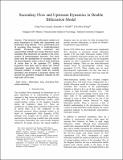| dc.contributor.author | Leong, Fong Yew | |
| dc.contributor.author | Smith, Kenneth A. | |
| dc.contributor.author | Wang, Chi-Hwa | |
| dc.date.accessioned | 2007-02-06T12:00:00Z | en_US |
| dc.date.available | 2007-02-06T12:00:00Z | en_US |
| dc.date.issued | 2007-01 | |
| dc.identifier.uri | http://hdl.handle.net/1721.1/35876 | |
| dc.description.abstract | Flow behavior in bifurcation models is of great importance to health risk assessments and pulmonary drug delivery. This is particularly true of secondary flow behavior in multi-bifurcation models. Previously, both numerical and experimental methods have shown that four-vortex secondary flow structures can develop in the cross-sections of grand-daughter branches. This work shows that the development of secondary flow in the grand-daughter tubes is due to local stretching of vortex lines in the upstream DT. Scaling arguments have been used to derive two critical parameters governing this particular vorticity transport problem. A simple model for vorticity generation and transport is proposed, taking into account the geometric limitations imposed by the rigid walls of the tubes. | en |
| dc.description.sponsorship | Singapore-MIT Alliance (SMA) | en |
| dc.language.iso | en | en |
| dc.relation.ispartofseries | Chemical and Pharmaceutical Engineering (CPE) | en |
| dc.subject | Bifurcation | en |
| dc.subject | Lung | en |
| dc.subject | Secondary Flow | en |
| dc.subject | Vortex Stretching | en |
| dc.title | Secondary Flow and Upstream Dynamics in Double Bifurcation Model | en |
| dc.type | Article | en |
